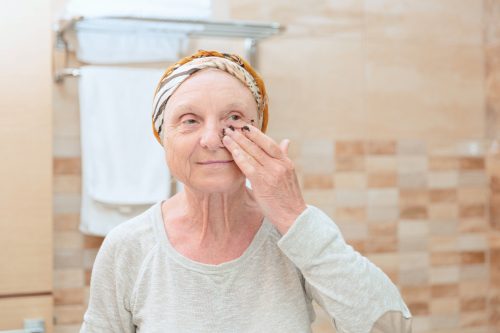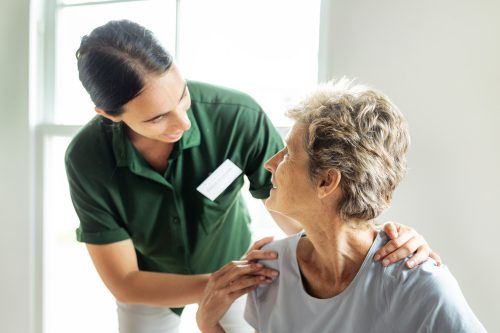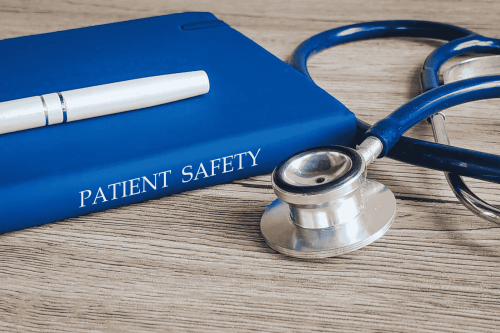
In assisted living, one of the most critical aspects of resident care is the prevention and management of skin issues. For instance, one of the most common risk factors associated with the development of pressure ulcers is being 70 years of age or older. Skin health is not only a matter of comfort and well-being but also a key indicator of a resident’s overall health status. Unfortunately, skin issues are common among the elderly due to factors like aging, chronic health conditions, and mobility limitations. This makes it essential for staff in assisted living facilities to be well-equipped with the knowledge and skills to address these issues effectively.
Empowering staff to address skin issues involves more than just training them to recognize and treat conditions. It requires fostering a culture of awareness, continuous learning, and proactive care. This blog will explore the importance of empowering staff to manage skin health in assisted living and provide actionable strategies for implementing effective skin care protocols.
The Importance of Skin Health in Assisted Living
Skin health is particularly crucial in assisted living settings, where elderly residents are more vulnerable to a range of skin conditions. These can vary from minor irritations to more severe problems such as pressure ulcers, infections, and skin tears. Without proper management, these issues can escalate into serious complications, including chronic infections, reduced mobility, and even life-threatening conditions. Are your caregivers fully equipped to recognize the early signs of these skin issues? Do they have a clear, effective protocol in place for immediate intervention?
Our Skin Health Management in Assisted Living Training online course is designed to address these challenges by providing comprehensive education for caregivers and staff. This course empowers your team with essential knowledge and practical skills to prevent, detect, and manage skin conditions effectively, ensuring the highest standard of care for your residents. By enrolling in this training, you will enhance your facility’s capacity to maintain optimal skin health, improve overall resident outcomes, and minimize the risk of complications associated with common skin issues among the elderly.
Common Skin Issues in Assisted Living

Pressure Ulcers
Also known as bedsores, these are injuries to the skin and underlying tissue resulting from prolonged pressure on the skin. Residents who are bedridden or have limited mobility are particularly at risk.
Skin Tears
Fragile skin in elderly individuals can tear easily, especially during transfers or when using medical equipment. Skin tears can lead to pain, infections, and delayed healing.
Dry Skin
Age-related changes and chronic conditions can lead to dry, flaky skin, which can cause discomfort and increase the risk of skin tears and infections.
Infections
The elderly often have weakened immune systems, making them more susceptible to skin infections, such as cellulitis, fungal infections, and shingles.
How often does your facility assess residents for early signs of pressure ulcers, and what preventative measures are currently in place? Are there specific strategies your team uses to minimize the risk of skin tears during daily activities or patient transfers? Addressing these issues promptly and effectively is crucial for maintaining the quality of life for residents. Empowering staff to recognize and manage skin conditions not only improves resident outcomes but also enhances the overall care provided by the facility.
Training and Education: The Foundation of Empowerment to Address Skin Issues in Assisted Living
The first step in empowering staff to address skin issues is providing comprehensive training and education. Staff members need to be knowledgeable about the various skin conditions that can affect elderly residents, how to prevent these issues, and the appropriate interventions when problems arise.
Understanding Skin Anatomy and Aging
Staff should be educated on the basic anatomy of the skin and how it changes with age. This includes understanding how aging affects skin elasticity, hydration, and the ability to heal.
Identifying Risk Factors
Training should cover the risk factors for skin issues, such as immobility, poor nutrition, incontinence, and chronic diseases like diabetes. Understanding these risk factors allows staff to implement preventative measures tailored to individual residents.
Recognizing Early Signs of Skin Issues
Early detection is critical in preventing minor skin issues from developing into more serious conditions. Staff should be trained to recognize the early signs of skin breakdown, pressure ulcers, infections, and other common skin problems.
Intervention and Treatment
Once a skin issue is identified, staff should know how to respond appropriately. This includes applying dressings, ensuring proper hygiene, using moisturizers, and when necessary, escalating care to a medical professional.
In addition to formal training, it’s important to encourage a culture of continuous learning. How does your facility support a culture of continuous learning and ensure staff are kept up-to-date on evolving skin care guidelines and best practices? Skin care guidelines and best practices evolve over time, and ongoing education ensures that staff remain up-to-date with the latest knowledge and techniques.
Implementing Effective Skin Care Protocols
Having well-trained staff is only one part of the equation. To truly empower staff to address skin issues, assisted living facilities must implement effective skin care protocols. These protocols should be clear, evidence-based, and integrated into the daily routines of the staff.
Develop Comprehensive Care Plans
Each resident should have a personalized care plan that includes specific skin care measures based on their individual risk factors. These plans should be developed in collaboration with healthcare providers, and regularly reviewed and updated.
Routine Skin Assessments
Regular skin assessments should be a standard part of care in assisted living facilities. These assessments can help detect early signs of skin issues and ensure timely intervention. Staff should document findings and communicate any concerns to the healthcare team.
Promote Mobility and Position Changes
For residents at risk of pressure ulcers, it’s important to promote mobility and encourage frequent position changes. Staff should be trained to assist residents with repositioning and to use supportive devices like cushions and mattresses designed to reduce pressure.
Hydration and Nutrition
Proper hydration and nutrition play a significant role in skin health. Staff should monitor residents’ fluid intake and ensure they receive a balanced diet rich in vitamins and minerals that support skin integrity. Nutritional supplements may be necessary for residents with specific deficiencies.
Incontinence Management
Incontinence can contribute to skin breakdown, especially in the perineal area. Staff should be trained in proper incontinence management, including the use of barrier creams, frequent changes of incontinence products, and maintaining skin hygiene.
Fostering a Culture of Proactive Care
Empowering staff to address skin issues effectively also requires fostering a culture of proactive care. This means creating an environment where prevention is prioritized, and staff are encouraged to take initiative in maintaining residents’ skin health.
Encourage Open Communication
Staff should feel comfortable discussing any skin-related concerns with their colleagues and supervisors. Creating a culture of open communication ensures that the team can address potential issues promptly and collaboratively.
Promote Teamwork
Skin care is a team effort. Encourage staff to work together, share insights, and support each other in implementing skin care protocols. Recognize and reward teamwork in addressing skin issues.
Monitor and Measure Outcomes
Regularly monitor the outcomes of skin care interventions. Afterwards, track key metrics such as the incidence of pressure ulcers or skin tears. This data will help you refine protocols and improve care quality.
Provide Support and Resources
Ensure that staff have access to the necessary resources, such as skin care products, dressings, and equipment. This will help them carry out their duties effectively. Lastly, always provide them with ongoing support through supervision and mentorship.
Are there existing team-building activities or initiatives that could be leveraged to strengthen teamwork in skin care management? What steps have you taken to further support staff in feeling empowered to take proactive measures in skin health management? Ongoing support, resources, and a culture of collaboration will help ensure that staff feel confident and capable of delivering the best possible care.
Conclusion: The Impact of Empowered Staff in Addressing Skin Issues in Assisted Living

Empowering staff to address skin issues in assisted living is not just about preventing and treating skin conditions—it’s about enhancing the overall quality of care. When staff are well-trained, supported, and encouraged to take a proactive approach to skin health, residents benefit from improved outcomes, greater comfort, and a higher quality of life.
Ensure compliance, boost efficiency, and foster trust in your facility with our customized training solutions. By empowering your staff with the skills and knowledge they need, you can elevate the standard of care while meeting regulatory requirements and building confidence among residents and their families.
Ready to make a difference? Enroll your large team in our customized, free course development program today and take the first step toward excellence in elder care! Click here.



